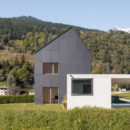April 27.2022

In 2019 she established her own company Nadia Vontobel Architekten GmbH
The starting point for the design was the concept that every newly built facade and roof surface could be used to generate electricity in addition to its function as the building envelope. At the same time, there was the architectural requirement to create a homely house that would blend well into its surroundings with its integrated photovoltaics. Consequently, the optimal use of solar energy was taken into account at an extremely early stage in the development of the programme and of the formulation of the building structure, and this has played a decisive role in shaping the architecture. The orientation of the building, the pitch of the roof and the recesses of the building volume are optimized to the maximum with regard to the generation of electricity, but at the same time take into account the existing outdoor qualities of the site. The matt and dark surface of the PV facade with its anthracite and brown tones contributes to a harmonious integration into the surrounding landscape.
The consistent use of all facade and roof surfaces in the practically fog-free Poschiavo, in combination with the ideal orientation and roof pitch of 35 degrees, results in considerable electricity production, especially in winter and the transitional period. An unusual feature of the Sol’CH project is the exploitation of the north facade and the steep north roof, which strengthens the overall architectural expression of the volume and at the same time, contributes to optimising electricity production.
The entire building envelope, as well as all building openings, windows, etc., required a high degree of accuracy, which placed the highest demands on the companies involved, especially in terms of coordination.
A special moment was when the scaffolding was taken down and the complete building envelope became visible for the first time.
Nowadays, PV roof surfaces are already quite common. But if we also want to promote winter energy and exploit the full potential of solar energy, we must also increasingly exploit facade surfaces. I am convinced that, in principle, architecturally high-quality facades can be realised through PV modules.
I have no specific preference for a particular technology. In my opinion, it is important to remain open to all innovations. I am curious to see where the technological development will lead in the next few years.


